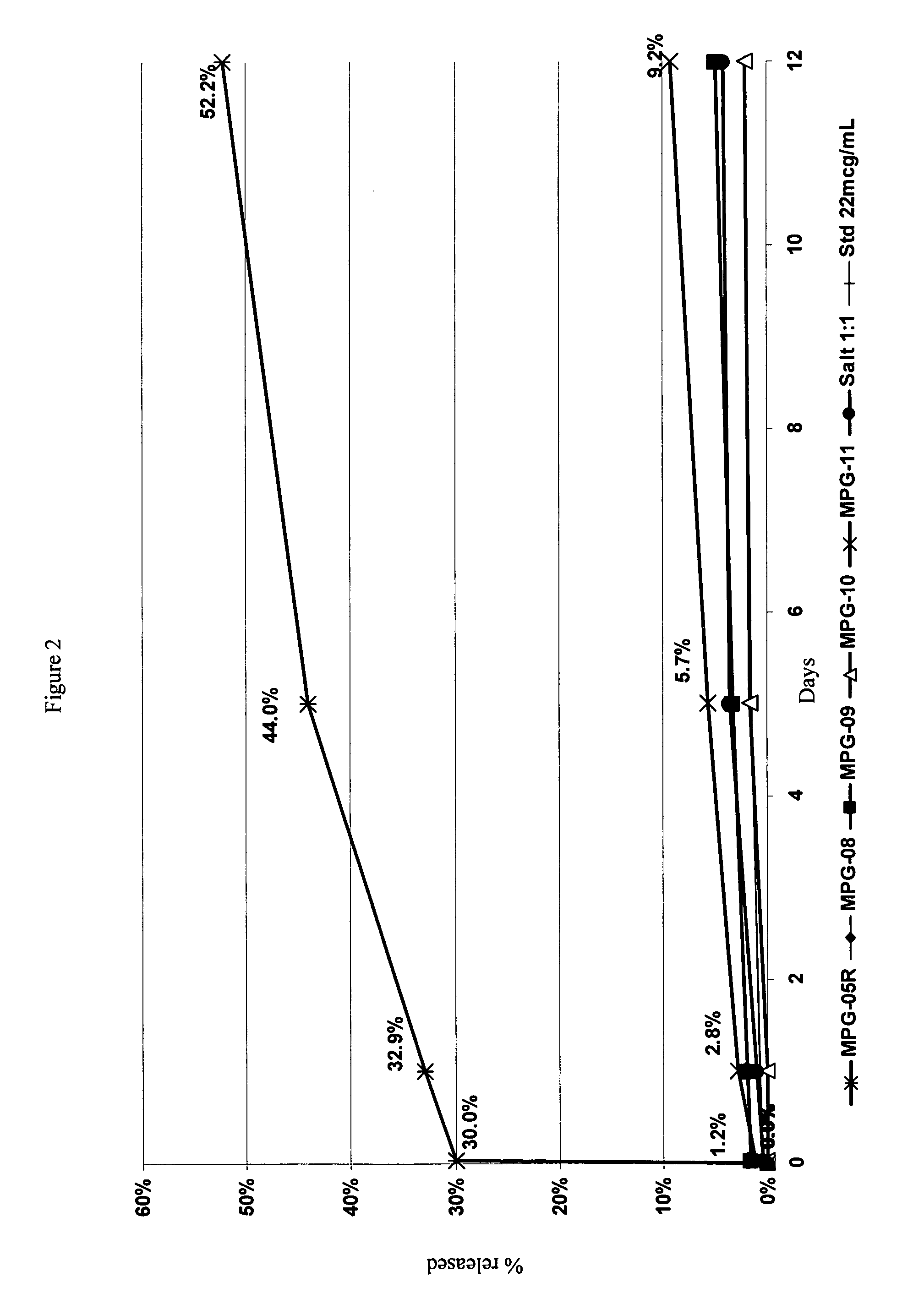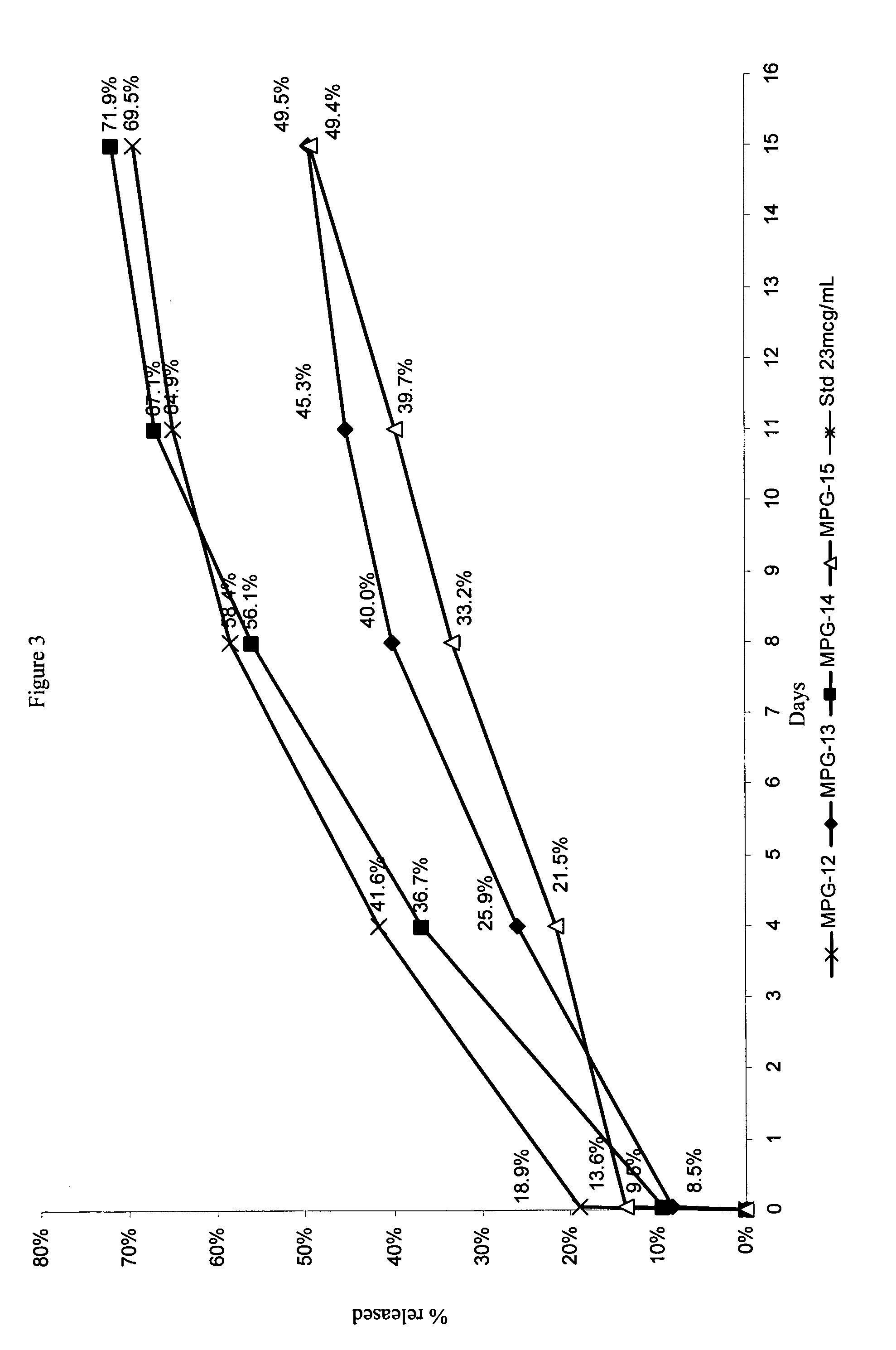Depot systems comprising glatiramer or a pharmacologically acceptable salt thereof
a glatiramer and acetate technology, applied in the direction of drug compositions, peptide/protein ingredients, immunological disorders, etc., can solve the problems of low patient compliance, presently limited to daily subcutaneous administration, and the route of administration has not been shown to achieve clinical efficacy in human patients, so as to reduce the total number of injections, reduce the frequency of drug dosing, and reduce the patient compliance
- Summary
- Abstract
- Description
- Claims
- Application Information
AI Technical Summary
Benefits of technology
Problems solved by technology
Method used
Image
Examples
example 1
General Preparation Methods
PLGA Based Injectable Depot Particles
[0060]Microparticles were prepared by solvent extraction / evaporation method (single emulsion). A solution of 50:50, dichloromethane / ethanol containing 250 mg PLGA and 200 mg glatiramer acetate was slowly poured into an aqueous solution (200 ml) containing 2% PVA and emulsified using a mechanical stirrer (300 rpm) at 25° C. The organic solvent was evaporated under stirring (100 rpm) for 2 h. The thus formed microparticles were collected by centrifugation and washed with distilled water to remove excessive emulsifier. The final suspension was then freeze-dried to obtain a fine powder.
Polycaprolactone Based Injectable Depot Particles
[0061]Microparticles were prepared by solvent extraction / evaporation method (single emulsion). A solution of 70:30, dichloromethane / acetone containing 500 mg polycaprolactone and 200 mg glatiramer acetate was slowly poured into an aqueous solution (200 ml) containing 2% PVA, 1% Tween 80 and emu...
example 2
Analytical Method—Assay of Glatiramer Acetate
Equipment
[0063]Spectrophotometer
[0064]Analytical balance, capable of accurately weighing to 0.01 mg
Materials and Reagents
[0065]Glatiramer acetate 83% as a reference standard
[0066]2,4,6-trinitrobenzenesulfonic acid (TNBS, picrylsulfonic acid, 170.5 mM) 5% in MeOH
[0067]0.1 M borate buffer pH 9.3 (sodium tetraborate decahydrate MW 381.37)
[0068]water, purified
[0069]volumetric pipettes for 0.5, 1.0, 2.0 and 7.0 mL
[0070]miscellaneous glassware.
Preparations
[0071]Preparation of Glatiramer Stock Solution 400 μg / mL
[0072]4.8 mg of glatiramer acetate (potency 83% as base for reference standard) were weighed into a 10 ml volumetric flask. Approximately 7 ml of 0.1 M borate buffer were added to afford dissolution of the glatiramer acetate in ultrasonic bath. The solution was further diluted with 0.1M borate buffer to obtain glatiramer stock solution 400 μg / ml (as base).
[0073]Preparation of 0.25% TNBS Working Solution
[0074]Prior to the use, 5% stock sol...
example 3
Preparation of PLGA Microparticles Loaded with Glatiramer Acetate
[0082]External (continuous) water phase: 30 ml of 0.75% NaCl solution in purified water, further containing 0.5% partially hydrolyzed (87-89%) polyvinyl alcohol (PVA) as a surfactant, 0.2% polysorbate-80 (Tween-80) for MPG-10 and 2% PVA for blank MP preparation.
[0083]Internal water phase (for peptide solution): 150-200 μl of purified water per 25-30 mg of glatiramer acetate. The glatiramer acetate was dissolved in water using an ultrasonic bath.
[0084]Organic polymeric solution (oil phase): 165-300 mg of PLGA in 2-5 mL of methylene chloride. Optionally, a counter-ion was further dissolved or dispersed in the organic phase.
[0085]Preparation Proceedings
[0086]Water in oil (w / o) emulsion preparation: Internal water phase, containing dissolved glatiramer acetate, was mixed directly in the test tube with the oil phase containing PLGA solution in CH2Cl2. The mixture was thoroughly shaken and treated with ultrasonic indenter (t...
PUM
| Property | Measurement | Unit |
|---|---|---|
| molar ratios | aaaaa | aaaaa |
| molar ratios | aaaaa | aaaaa |
| molar ratios | aaaaa | aaaaa |
Abstract
Description
Claims
Application Information
 Login to View More
Login to View More - R&D
- Intellectual Property
- Life Sciences
- Materials
- Tech Scout
- Unparalleled Data Quality
- Higher Quality Content
- 60% Fewer Hallucinations
Browse by: Latest US Patents, China's latest patents, Technical Efficacy Thesaurus, Application Domain, Technology Topic, Popular Technical Reports.
© 2025 PatSnap. All rights reserved.Legal|Privacy policy|Modern Slavery Act Transparency Statement|Sitemap|About US| Contact US: help@patsnap.com



